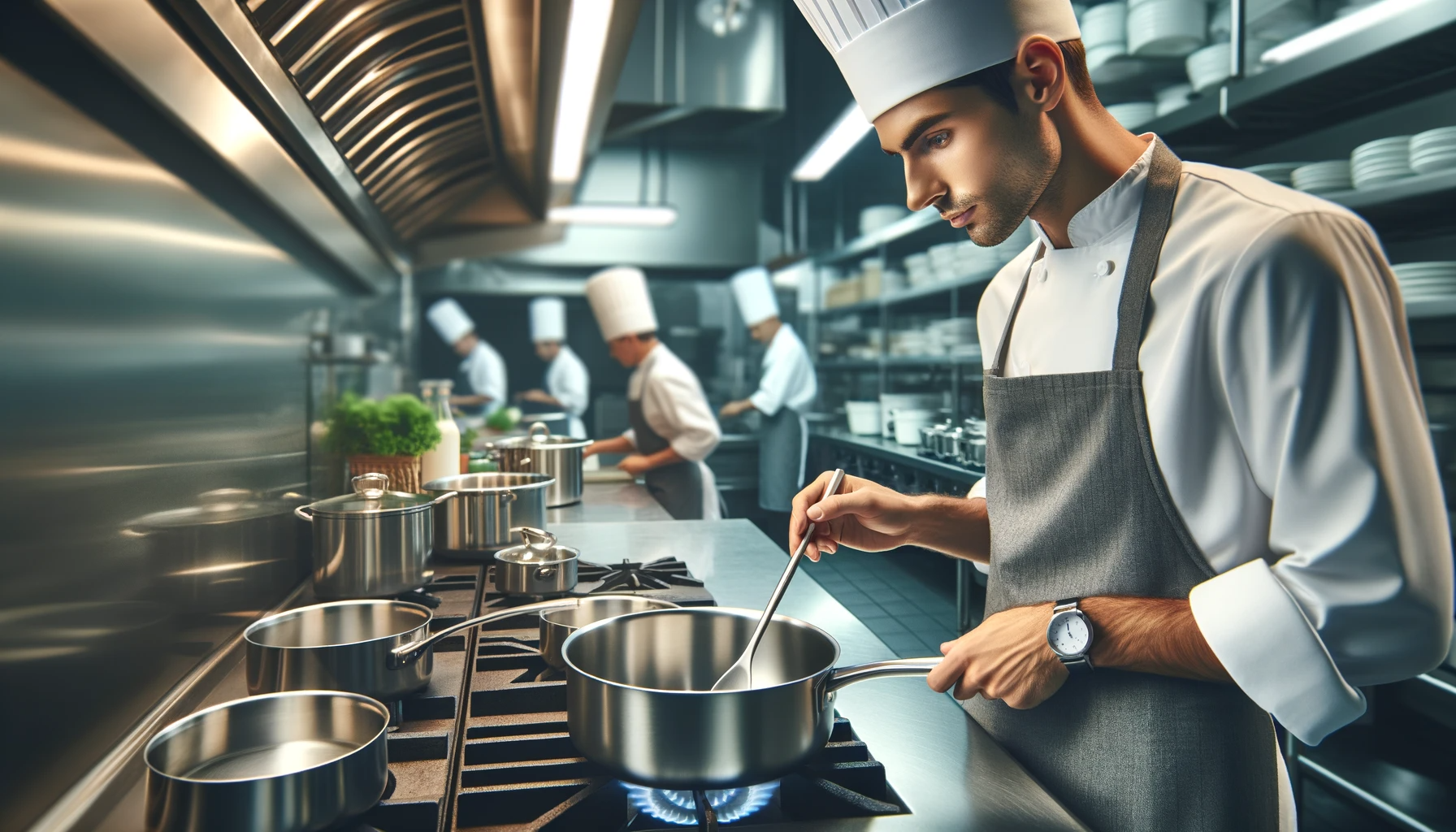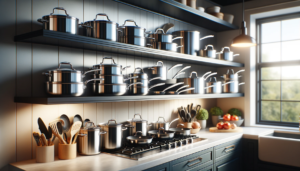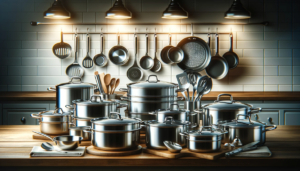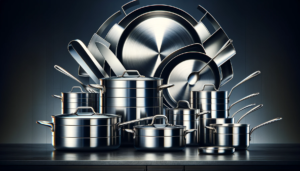Ever wonder why most restaurant and hotel kitchens use shiny steel pots and pans instead of the more colorful cookware in our homes?
Stainless steel is the gold standard for professional chefs because of its durability, heating efficiency, ease of cleaning, neutrality towards food, lifecycle cost savings, and aesthetic qualities that support their artistry and business reputations every day.
Let’s examine why commercial cooks overwhelmingly choose hardy stainless steel over all other materials to meet their unique demands.
Why Do Professional Chefs Use Stainless Steel Cookware?
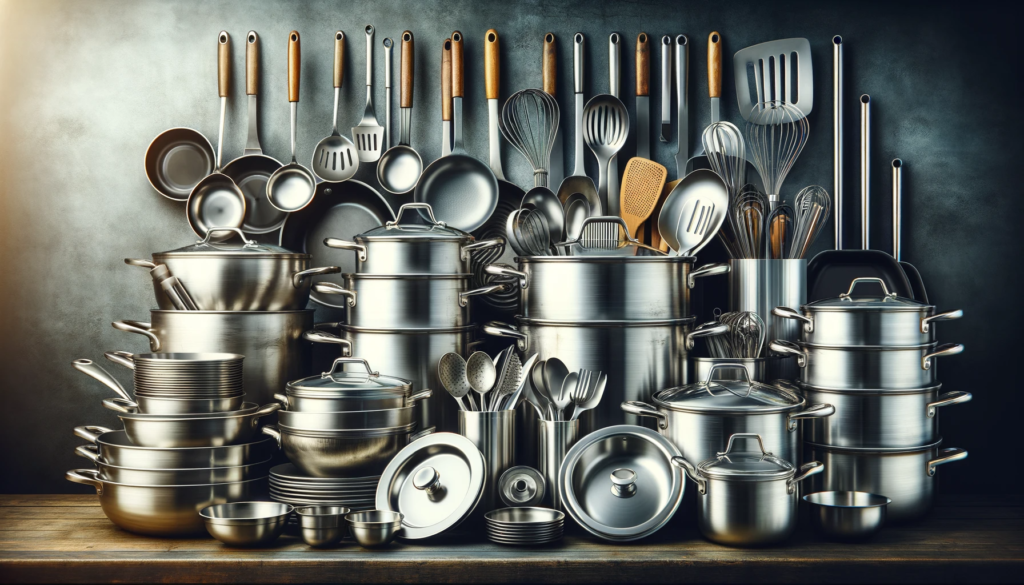
Professional chefs overwhelmingly choose stainless steel pots and pans because stainless steel withstands the demands of commercial kitchens better than any other material.
It offers superior durability, heating efficiency, cleanability, non-reactivity, longevity, and aesthetic quality important for prolific food service establishments striving for excellence day in and out.
We will explore below in detail why stainless steel has emerged as the dominant standard for cookware across professional kitchens of all types and sizes.
Durability Of Stainless Steel Cookware
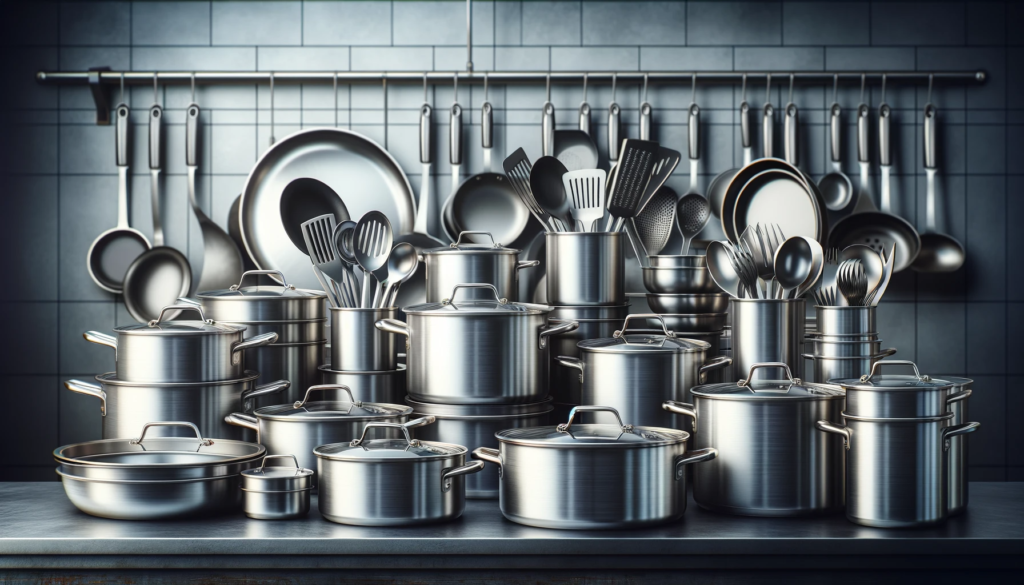
Stainless steel is very durable and stands up to heavy daily use in a professional kitchen.
Stainless steel resists dents, warping, and corrosion better than other materials like aluminum or copper.
Stainless steel maintains its strength and performance over many years of wear and tear.
Professional kitchens involve cooking large volumes of food on a daily basis.
The cookware faces high heat and contact with metal utensils.
Stainless steel is rugged enough to withstand this heavy-duty environment.
The hardness of stainless steel allows it to resist scratches, dents and deformation from constant use.
Its stabilized structure containing chromium prevents rusting or corrosion over time.
This level of durability allows professional chefs to use the same stainless steel pots and pans for many years.
Aluminum and copper cookware often used in home kitchens cannot endure this punishing professional environment.
Aluminum dents easily, while copper is soft and scratches more readily.
Neither holds up physically as long or as well as stainless steel does for pro chefs.
Stainless steel’s unparalleled durability makes it worth the moderate additional cost for busy commercial kitchens.
Ability Of Stainless Steel Cookware To Heat Evenly
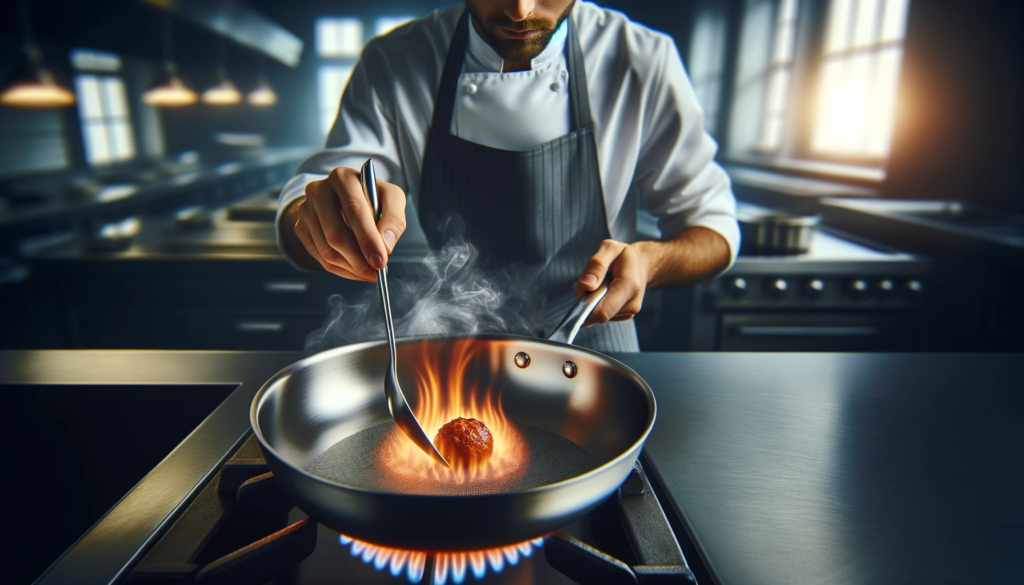
Stainless steel cookware heats evenly and efficiently on the stove or in the oven.
It avoids hot spots that can lead to burning food.
Even heating allows better control and consistency in cooking.
The aluminum or copper cores sandwiched within layers of stainless steel conducts heat well across the entire pan surface.
This enables even distribution of heat to avoid scalding or scorching the food unevenly.
With reliable even heating, chefs can better regulate cooking temperatures.
This increases efficiency in busy kitchens expected to churn out consistent dishes every time.
In contrast, cookware made entirely of materials like aluminum or ceramic tend to develop significant hot spots.
Food cooked over these hot spots has a propensity to burn.
Uneven cooking makes it tricky for chefs to time and standardize the food output.
Stainless steel eliminates this aggravation with its evenly heated surface ideal for quality and consistency.
Ease Of Cleaning And Maintenance With Stainless Steel
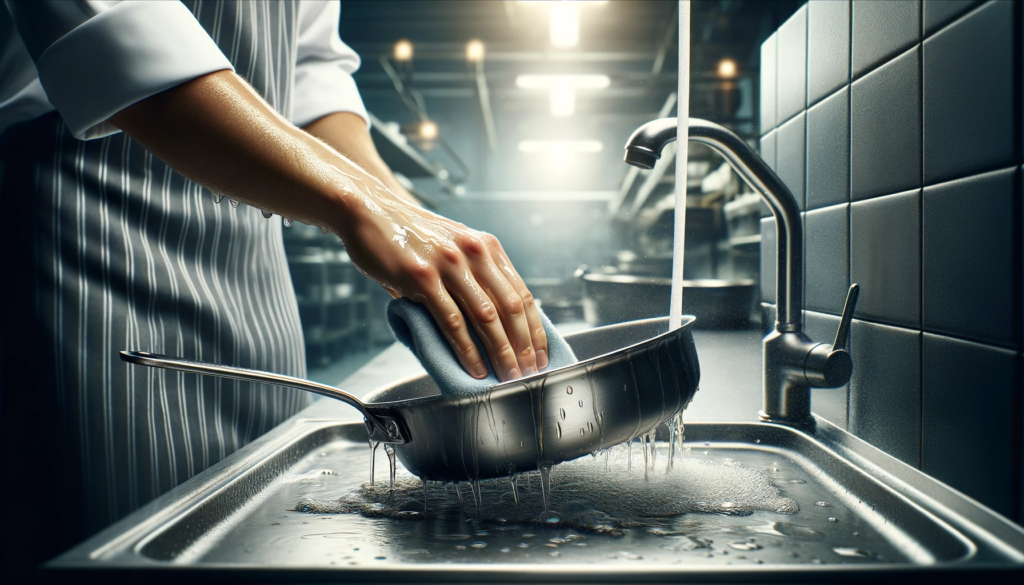
Smooth, nonporous surface of stainless steel makes cleaning easy.
Unlike nonstick coatings, stainless steel holds up to frequent scrubbing.
Stainless steel is dishwasher safe and sterilizes well for sanitation standards.
The slick, polished stainless steel finish does not trap food debris or oils.
Cooked-on food wipes off easily avoiding the need for scouring.
This saves time in busy commercial kitchens required to meet sanitation norms.
Stainless steel cleans up well in the dishwasher repeatedly without warping or affecting food taste later.
While nonstick pans offer easy cleaning too, their coatings often scratch or wear out over time especially with the heavy duty use of a pro kitchen.
This exposes the base metal underneath also damaging the nonstick properties.
Stainless steel saves chefs this hassle with its durable surface that cleans up like new every time.
Non-Reactive Properties Of Stainless Steel
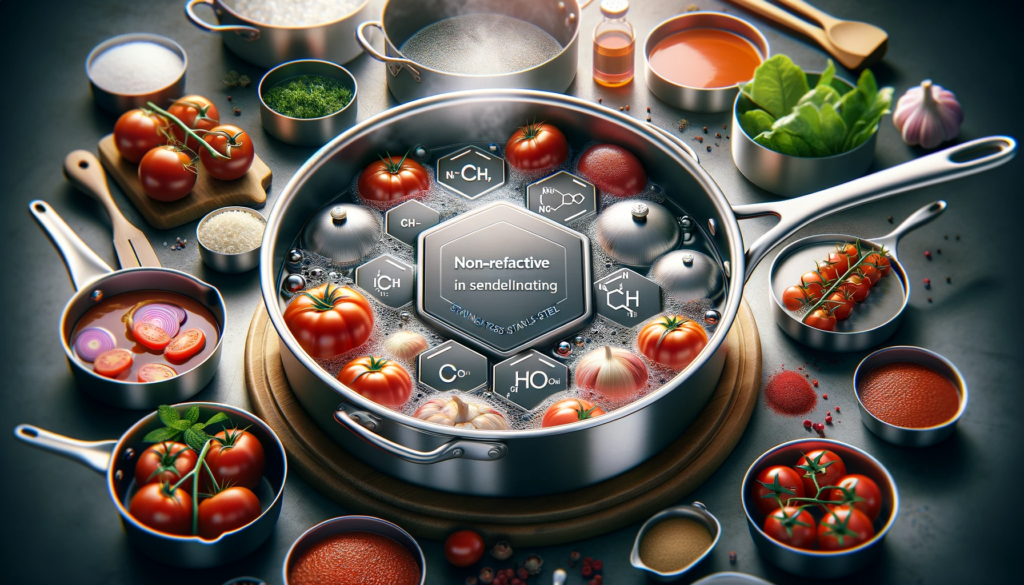
Stainless steel does not react with or alter acidic foods during cooking.
No metallic tastes are transferred to foods.
Safe for cooking a wide variety of ingredients.
The adding of chromium to steel makes it resistant to reactivity.
This prevents chemical interactions between stainless steel cookware and ingredients that can alter flavors.
Acidic foods like tomatoes cooked in bare metal pots often absorb a metallic taste.
Stainless steel precludes this issue allowing purity of flavors to shine through.
This non-reactive nature of steel also prevents corrosion by acidic foods.
Reaction with acidic ingredients can pit or damage cookware surfaces like ceramics over time.
Stainless steel’s bio-neutral properties significantly increase cookware lifespan.
This perfectly suits commercial kitchens required to safely cook a diverse range of foods while retaining original flavors.
Professional Appearance Of Stainless Steel Cookware
Brushed or mirror-polished stainless steel looks clean, elegant and professional.
It conveys quality and attention to detail in a commercial kitchen.
Stainless steel matches other kitchen décor and appliances.
The lustrous and attractive finish gives any professional cook space an upscale feel customers notice.
Stainless steel’s neutral shades blend seamlessly with most kitchen color schemes compared to the warm tones of copper pans.
Matching appliances and surfaces create a harmonious visual impact.
Shiny stainless steel cookware also highlights a commitment to quality that diners find reassuring.
Its appearance conveys care and pride chefs take in their art.
Even after years of service, stainless steel retains its fine finish rather than looking worn out like other cookware materials.
Its timeless beauty continues evoking excellence in cuisine.
Easy Maintenance Of Appearance
While nonstick cookware easily looks greasy or grimy after cooking, stainless steel appearances revive easily.
Stainless steel’s nonporous and smooth surface prevents grease buildup.
Any visible dirt polishes out nicely.
This helps maintain the positive impression stainless steel cookware conveys in busy commercial kitchens.
Pitting, peeling or flaking issues with other materials never diminish stainless steel’s visual uniformity.
Dents and scratches buff out restoring original attractive finishes.
Stainless steel cookware thus keeps commercial kitchens looking sharp with relatively low upkeep.
Its lasting aesthetic quality contributes greatly to consistent quality perceptions customers expect.
Matching Other Kitchen Equipment
Stainless steel has become exceptionally popular in professional kitchens.
Using matching stainless steel cookware completes the unified, upscale look.
It also avoids a piecemeal appearance from equipment bought separately over time.
Consistent finishes also imply consistent quality throughout.
Stainless steel prep tables, shelves, sinks and appliances cohesively project excellence when paired with similar cookware.
Clean, professional stainless meshes beautifully rather than looking haphazard.
Visual continuity also indirectly emphasizes high cleanliness standards.
This consistent image makes powerful impressions diners appreciate.
Cost Efficiency Of Stainless Steel Cookware
While quality stainless steel pots and pans have moderately higher upfront expenses, their extraordinary lifespan delivers return on investment over years of use.
Commercial kitchens prioritizing economy choose stainless steel.
At food service levels of use, most other cookware materials wear out requiring replacement much quicker.
Their lower cost gets negated by more frequent purchases rendering expenses higher in the long run.
Commercial kitchens benefit most from stainless steel’s durability saving massively on replacements alone.
Savings On Fuel Usage
Stainless steel’s superior heat conduction compared to other metals like aluminum also increases fuel efficiency slightly.
This compounds long term savings from using stainless steel cookware.
The aluminum or copper cores in steel plates heat up faster allowing burners to be turned down sooner during cooking.
Faster heating also leads to faster simmering or boiling that takes less time.
These improved efficiencies incrementally conserve gas or electric costs over hundreds of daily cooking cycles.
Low Maintenance Costs
Easy maintenance of stainless steel further alleviates operating expenses for commercial kitchens.
The effortless cleaning without needing special supplies reduces labor overheads.
Stainless steel’s high corrosion and tarnish resistance eliminates the need for expensive special cleaners or polish upkeep too.
These lasting low maintenance attributes make stainless steel a bargain considering the thousands saved in labor and upkeep over years.
Stainless steel does cost moderately more than extremely cheap options like aluminum.
However, lower grade metals sacrifice on every other beneficial attribute like aluminum’s high tendency to warp.
Stainless steel clearly surpasses others on value if the many tangible and intangible benefits get factored into the lifetime cost.
Health And Safety Cost Savings
Commercial kitchens also benefit financially from stainless steel’s neutrality towards food ingredients.
Cooking a wide variety of foods safely in the same pans maximizes usability lowering equipment needs.
Unlike reactive metals, stainless steel never compromises integrity of dishes raising risks of food safety violations.
This saves reputational damages and potential health issues that prove far costlier over time.
Conclusion
In conclusion, stainless steel cookware offers professional chefs durability, even heating, easy cleaning, non-reactivity, cost savings, and aesthetic appeal far superior to other cookware materials.
While more expensive upfront than options like aluminum, stainless steel pans deliver outstanding return on investment over their extraordinarily long lifespans in busy commercial kitchens.
No other cookware combines ruggedness with performance and beauty like stainless steel does.
This makes it the top choice for culinary professionals striving for excellence.
